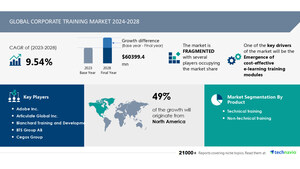NEW YORK, June 4, 2024 /PRNewswire/ -- The global bunker fuel market size is estimated to grow by USD 30.1 billion from 2024-2028, according to Technavio. The market is estimated to grow at a CAGR of over 4.18% during the forecast period.
For comprehensive forecast and historic data on regions, market segments, customer landscape, and companies- Click for the snapshot of this report
Bunker Fuel Market Scope |
|
Report Coverage |
Details |
Base year |
2023 |
Historic period |
2018 - 2022 |
Forecast period |
2024-2028 |
Growth momentum & CAGR |
Accelerate at a CAGR of 4.18% |
Market growth 2024-2028 |
USD 30.1 billion |
Market structure |
Fragmented |
YoY growth 2022-2023 (%) |
3.93 |
Regional analysis |
APAC, Europe, Middle East and Africa, North America, and South America |
Performing market contribution |
APAC at 33% |
Key countries |
China, Germany, US, India, and Saudi Arabia |
Key companies profiled |
BP Plc, Chevron Corp., Eni SpA, Exxon Mobil Corp., Gulf Agency Co. Ltd., Indian Oil Corp. Ltd., Marathon Petroleum Corp., Marquard and Bahls AG, Neste Corp., PETRONAS Chemicals Group Berhad, PJSC LUKOIL, Rosneft Oil Co., Saudi Arabian Oil Co., Shell plc, and TotalEnergies SE |
Market Driver
The LNG market for bunker fuel is experiencing notable growth due to the rising demand for cleaner marine fuel. LNG's advantages, such as odorless, non-toxic, and non-corrosive properties, make it an attractive alternative to oil-based fuels. Its compliance with current emission norms, including SOx, NOx, and CO2 reductions, aligns with stricter MARPOL VI regulations.
Retrofitting capabilities and increasing LNG projects contribute to this trend. Container shipping companies are also developing LNG-powered vessels to meet future energy needs and emission regulations. The transport sector in China, the fastest-growing LNG demand globally, further highlights the potential expansion of the LNG bunker fuel market.
The bunker fuel market has seen significant trends in recent years. The demand for low-sulfur fuel has increased due to stricter regulations on emissions. Companies are investing in producing and supplying this fuel to meet the growing demand. The use of conventional bunker fuel is decreasing as vessels opt for cleaner alternatives.
The cost of bunker fuel has also been a concern, with prices fluctuating based on supply and demand. The market is expected to continue this trend, with a focus on sustainability and reducing emissions. The use of biofuels and other alternative fuels is gaining popularity in the industry. Overall, the bunker fuel market is evolving to meet the changing needs of the maritime industry.
Market Challenges
- The bunker fuel market is significantly influenced by crude oil prices. The market experienced a downturn due to the supply-demand imbalance, leading to decreased revenues for upstream oil and gas companies. However, this price decline benefited the shipping industry with lower fuel costs and increased demand for storage space.
- As crude oil prices stabilize, bunker fuel costs are expected to rise, impacting vendor operating costs. New transportation routes chosen during the price downturn may need reevaluation due to potential fuel cost infeasibility. These crude oil price fluctuations can hinder the growth of the global bunker fuel market.
- The bunker fuel market faces several challenges in the shipping industry. One major challenge is the increasing cost of fuel, particularly heavy fuel oil. Another challenge is the implementation of stricter regulations on emissions, which requires the use of cleaner fuels. The transition to low-carbon fuels is also a significant challenge, as the infrastructure for their production and distribution is still developing.
- Additionally, geopolitical tensions and supply disruptions can impact the availability and price of bunker fuel. Furthermore, the COVID-19 pandemic has led to a decrease in demand for bunker fuel due to reduced shipping activities. Overall, these challenges require innovative solutions and adaptability from market players to ensure the sustainability and efficiency of the bunker fuel market.
Research report provides comprehensive data on impact of trend, driver and challenges - Request a sample report!
Segment Overview
- Type
- 1.1 MGO
- 1.2 HSFO
- 1.3 VLFSO
- Application
- 2.1 Container
- 2.2 Bulk carrier
- 2.3 Oil tanker
- 2.4 General cargo
- 2.5 Chemical tanker
- Geography
- 3.1 APAC
- 3.2 Europe
- 3.3 Middle East and Africa
- 3.4 North America
- 3.5 South America
1.1 MGO- Marine gas oil (MGO) is a refined distillate fuel used in ships and marine vessels due to its lower sulfur content and easier handling compared to heavy fuel oils (HFO). Compliant with stricter emissions regulations, MGO is popular in areas with emission control regulations. Its cleaner-burning properties result in reduced emissions of SO2, NOx, and particulate matter, making it an essential choice for ships with engines not optimized for HFO. The demand for MGO is expected to increase due to its low viscosity and complete combustion properties.
For more information on market segmentation with geographical analysis including forecast (2024-2028) and historic data (2017-2021) - Download a Sample Report
Research Analysis
The Bunker Fuel Market is a significant segment in the marine fuels industry, particularly in the cruise sector. With increasing global trade trends and the backbone of international logistics, the demand for marine fuels remains constant. However, there is a driving factor towards cleaner fuels with lower sulphur content. Sulfur fuel with reduced emissions is becoming a priority for marine transportation due to emission regulations and the carbon footprint concern.
Infrastructure construction, such as LNG bunkering vessels and LNG ports, is on the rise to support the transition towards LNG-powered vessels and Liquefied Bio Methane. Key global trade trends include the conversion of existing vessels to LNG-powered propulsion and the expansion of LNG bunkering in ports like Portsmouth, Saint-Malo, and Ouistreham. Cargo operations are also adapting to these changes, contributing to the overall progress towards global decarbonization goals.
Market Research Overview
The bunker fuel market encompasses a significant portion of the global energy sector, primarily serving the maritime industry. This essential fuel type is derived from heavy crude oils and residues. Its high energy density makes it an ideal choice for large-scale energy consumption, particularly in shipping. The bunker fuel market faces various challenges, including stringent environmental regulations, increasing competition from alternative fuels, and price volatility.
Despite these hurdles, the market continues to grow due to the increasing demand for international trade and the expansion of global shipping routes. The versatility of bunker fuel, coupled with its availability and affordability, ensures its continued relevance in the energy landscape.
Table of Contents:
1 Executive Summary
2 Market Landscape
3 Market Sizing
4 Historic Market Size
5 Five Forces Analysis
6 Market Segmentation
- Type
- MGO
- HSFO
- VLFSO
- Application
- Container
- Bulk Carrier
- Oil Tanker
- General Cargo
- Chemical Tanker
- Geography
- APAC
- Europe
- Middle East And Africa
- North America
- South America
7 Customer Landscape
8 Geographic Landscape
9 Drivers, Challenges, and Trends
10 Company Landscape
11 Company Analysis
12 Appendix
About Technavio
Technavio is a leading global technology research and advisory company. Their research and analysis focuses on emerging market trends and provides actionable insights to help businesses identify market opportunities and develop effective strategies to optimize their market positions.
With over 500 specialized analysts, Technavio's report library consists of more than 17,000 reports and counting, covering 800 technologies, spanning across 50 countries. Their client base consists of enterprises of all sizes, including more than 100 Fortune 500 companies. This growing client base relies on Technavio's comprehensive coverage, extensive research, and actionable market insights to identify opportunities in existing and potential markets and assess their competitive positions within changing market scenarios.
Contacts
Technavio Research
Jesse Maida
Media & Marketing Executive
US: +1 844 364 1100
UK: +44 203 893 3200
Email: [email protected]
Website: www.technavio.com/
SOURCE Technavio

WANT YOUR COMPANY'S NEWS FEATURED ON PRNEWSWIRE.COM?
Newsrooms &
Influencers
Digital Media
Outlets
Journalists
Opted In




Share this article